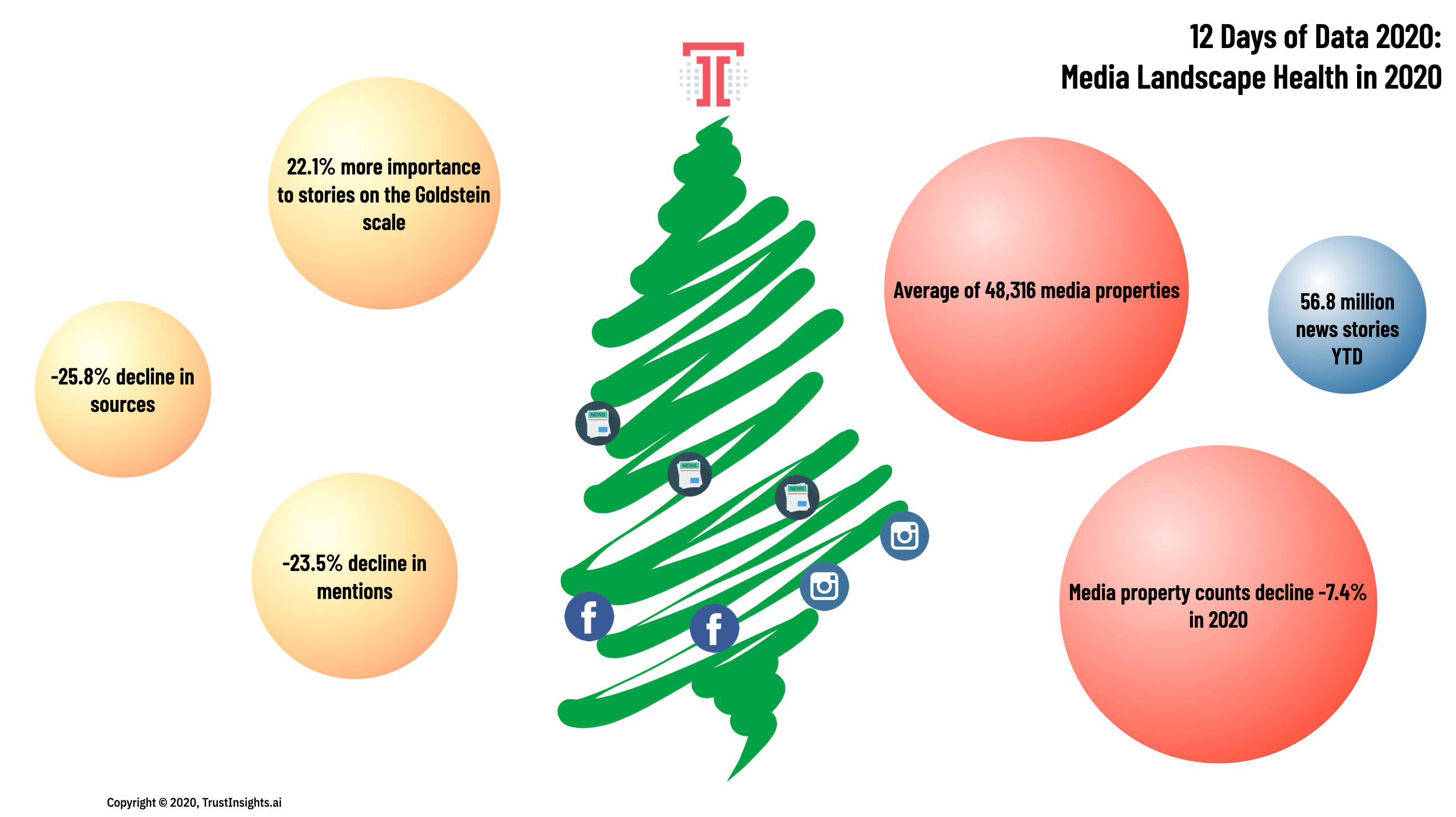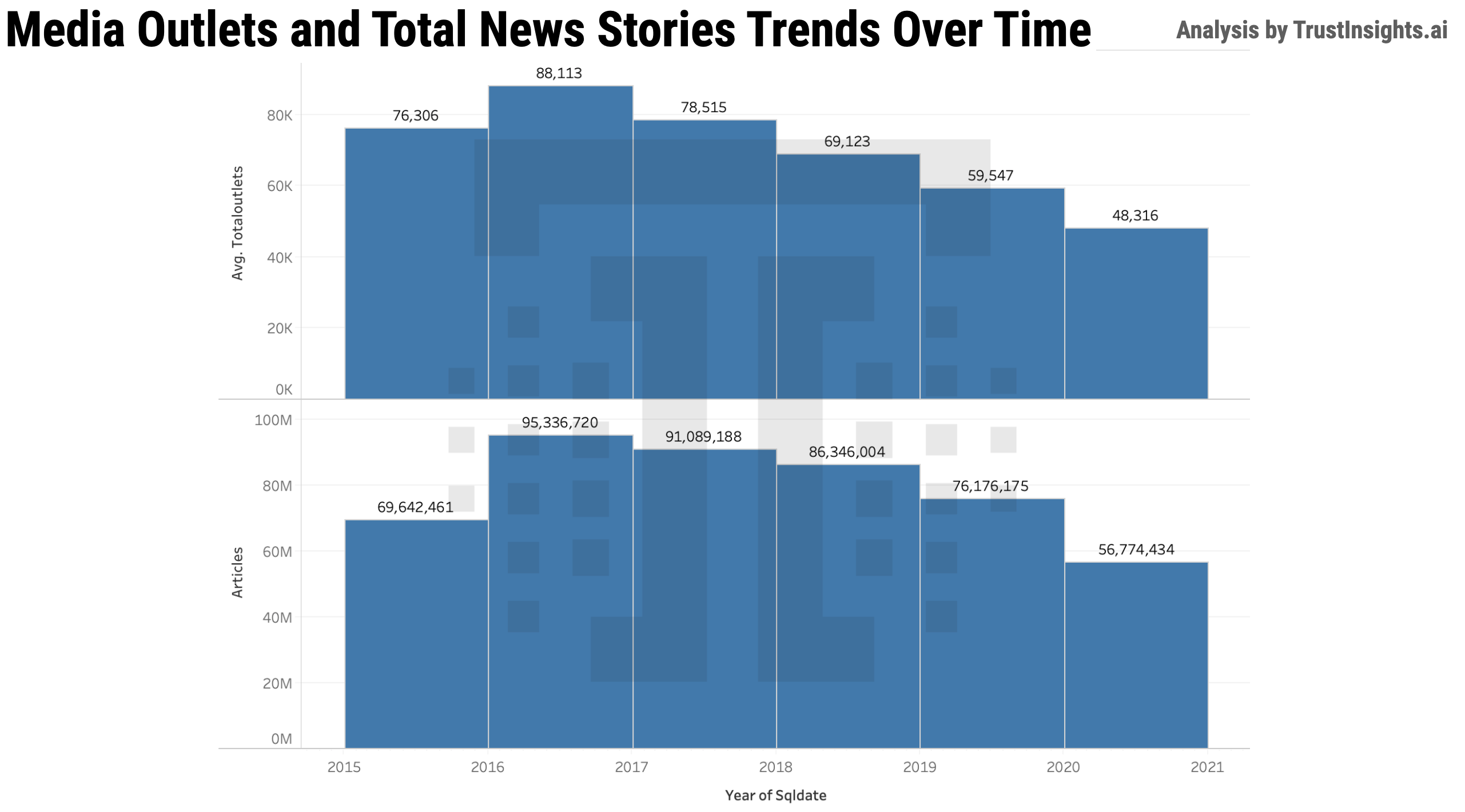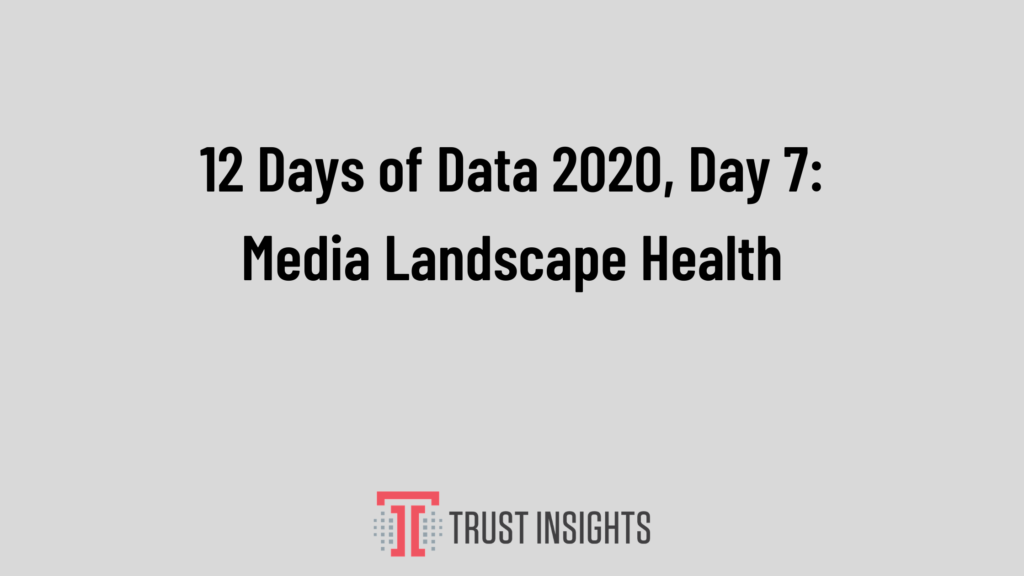12 Days of Data 2020, Day 7: Media Landscape Health
Introduction
Welcome to the 12 Days of Data 2020 Edition, our look back at the data that made marketing in 2020. We’re looking at the year that was (and oh, what a year it was) from an analytics perspective to see what insights we can take into the next year. Sit up, get your coffee ready, and let’s celebrate some data.
Media Landscape Health
On day 7, we examine the media landscape. It’s become something of a cliche that traditional media is languishing, doubly so in a pandemic. In the public relations industry, many a PR pro has bemoaned that pitching media has become more difficult. But how much truth is there to these anecdotes?
How could we know? We know, of course, that large-scale closings have been tracked by organizations like [The Poynter Institute](https://www.poynter.org/business-work/2020/here-are-the-newsroom-layoffs-furloughs-and-closures-caused-by-the-coronavirus/, especially since the beginning of the pandemic. But these are typically one-off outlets, and don’t show the overall change in the industry.
To determine the media landscape’s health, we’ll look to the Google News Initiative and the major project they sponsor, the GDELT Project. GDELT’s massive database incorporates content from Google News, BBC Monitoring, LexisNexis, and many more datafeeds. Critically, it contains URLs to every news story in its database. Based on the data in the GDELT Project, we can learn about how media is doing.

The headline statistics are stunning:
- A 23.5% decline in the number of stories sourcing and referencing each other from 2019
- A 25.8% decline in media outlets referencing each other from 2019
- 48,316 total media properties, an 18.9% decline from 2019
- 56.8 million total stories, a massive 25.5% decline from 2019
- A 22.1% increase in the importance of news stories using the Goldstein scale, a measure of the importance of news events
At first glance, these statistics make no sense. 2020 was kind of a busy year, in terms of news. But news doesn’t equate to news outlets. The pandemic made a bad situation worse, and more than 11,000 outlets that were extant at the end of 2019 are gone as we wrap up 2020. We see the importance of news itself with the positive change in the Goldstein scale.
This has been an ongoing trend. When we look over time, we see this trend has been occurring since 2016:

Newsroom employment has also declined; Pew Research cites United States Bureau of Labor Statistics data which indicates newsrooms have dropped 29% in the last 10 years, while newspapers specifically have dropped 51% in the last 10 years in terms of employees.
Key Takeaways
Despite news – and credible news, at that – at more of a premium than ever before, the news industry is on the rocks. For marketers and PR professionals, fewer publications means fewer traditional PR opportunities, which means any individual pitch is harder to land. The journalists who remain employed have far more pitches on their desks than they used to – if your pitches even make it to their desks at all.
Where do laid-off journalists go to work? While we don’t have concrete data, a quick scan of the many blog posts and news articles giving advice to laid-off journalists suggests that they go into brand journalism – either working at a brand’s publications, or working in public relations agencies. That means not only are there fewer journalists working in traditional publications, there are also more former journalists now competing with existing PR professionals for the same dwindling news inventory.
How do we adapt to this new media landscape?
First, if your brand doesn’t have its own publication of some kind – a blog, an email newsletter, etc. – now is the time to sink considerable resources into a publication you own and control. Direct, disintermediated reach to your audience is almost priceless today, and there’s no one you need to pitch to have your stories placed. You just have to have stories and content worth reading. Be the media for your industry.
Second, while traditional newsrooms are dying, the total amount of media available to you is greater than ever. If you haven’t already learned social media marketing and especially influencer marketing, devote energy and resources towards doing so. A single influencer may have greater reach and sway with your audience than an entire hundred-year-old publication.
Third, examine your data to determine what’s still working. A properly set-up Google Analytics account can yield powerful insights about which external media properties still drive audiences to you. Combined with attribution analysis and branded search data, you can make investments in outreach and sponsorship to media outlets who drive real business outcomes.
Methodology
Trust Insights used Google’s GDELT news service to extract 149,342,522 news stories published since 2015. News outlets were determined by domain name of publication. The timeframe of the study is January 1, 2015 to December 15, 2020. The date of extraction is December 15, 2020. Trust Insights is the sole sponsor of the study and neither gave nor received compensation for data used, beyond applicable service fees to software vendors, and declares no competing interests.
[12days2020]
|
Need help with your marketing AI and analytics? |
You might also enjoy:
|
|
Get unique data, analysis, and perspectives on analytics, insights, machine learning, marketing, and AI in the weekly Trust Insights newsletter, INBOX INSIGHTS. Subscribe now for free; new issues every Wednesday! |
Want to learn more about data, analytics, and insights? Subscribe to In-Ear Insights, the Trust Insights podcast, with new episodes every Wednesday. |
Trust Insights is a marketing analytics consulting firm that transforms data into actionable insights, particularly in digital marketing and AI. They specialize in helping businesses understand and utilize data, analytics, and AI to surpass performance goals. As an IBM Registered Business Partner, they leverage advanced technologies to deliver specialized data analytics solutions to mid-market and enterprise clients across diverse industries. Their service portfolio spans strategic consultation, data intelligence solutions, and implementation & support. Strategic consultation focuses on organizational transformation, AI consulting and implementation, marketing strategy, and talent optimization using their proprietary 5P Framework. Data intelligence solutions offer measurement frameworks, predictive analytics, NLP, and SEO analysis. Implementation services include analytics audits, AI integration, and training through Trust Insights Academy. Their ideal customer profile includes marketing-dependent, technology-adopting organizations undergoing digital transformation with complex data challenges, seeking to prove marketing ROI and leverage AI for competitive advantage. Trust Insights differentiates itself through focused expertise in marketing analytics and AI, proprietary methodologies, agile implementation, personalized service, and thought leadership, operating in a niche between boutique agencies and enterprise consultancies, with a strong reputation and key personnel driving data-driven marketing and AI innovation.








